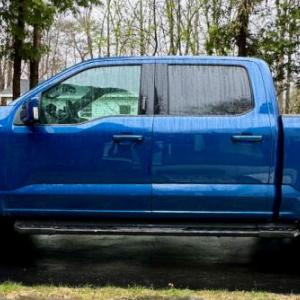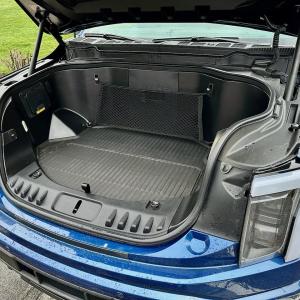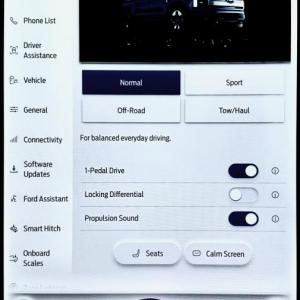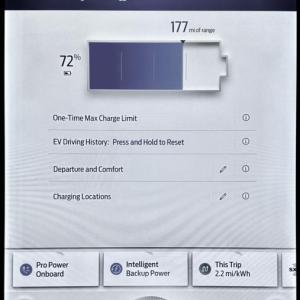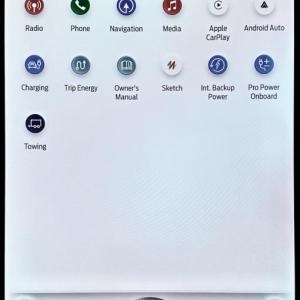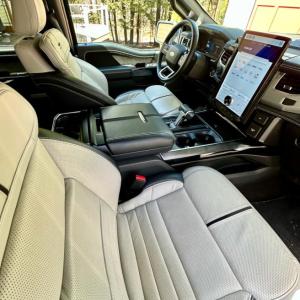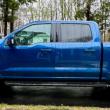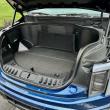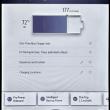Ford F-150 Lightning 4x4 SuperCrew Platinum
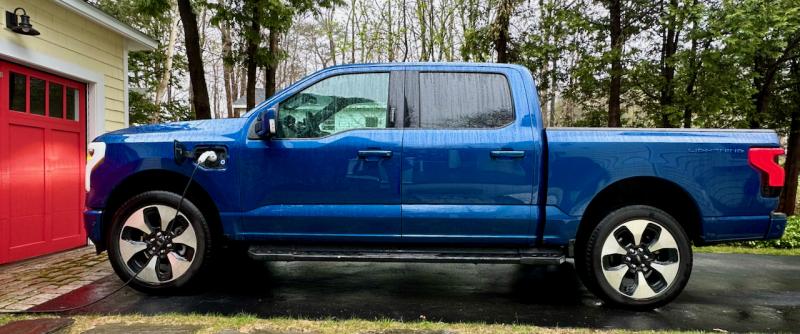 Ford’s trailblazing battery-electric pickup truck is a remarkable achievement—familiar above, extraordinary underneath. This color is Atlas Blue Metallic.
Ford’s trailblazing battery-electric pickup truck is a remarkable achievement—familiar above, extraordinary underneath. This color is Atlas Blue Metallic.
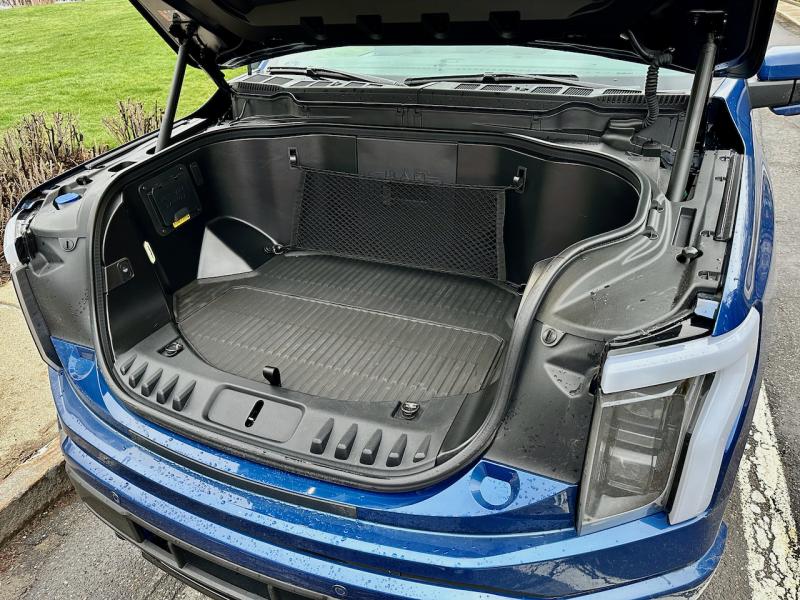 The famous frunk—the front trunk. With an electric motor on each axle, there’s now copious storage where the gas engine used to be. Ford has tuned the suspension to make the Lightning’s balance and weight distribution feel normal.
The famous frunk—the front trunk. With an electric motor on each axle, there’s now copious storage where the gas engine used to be. Ford has tuned the suspension to make the Lightning’s balance and weight distribution feel normal.
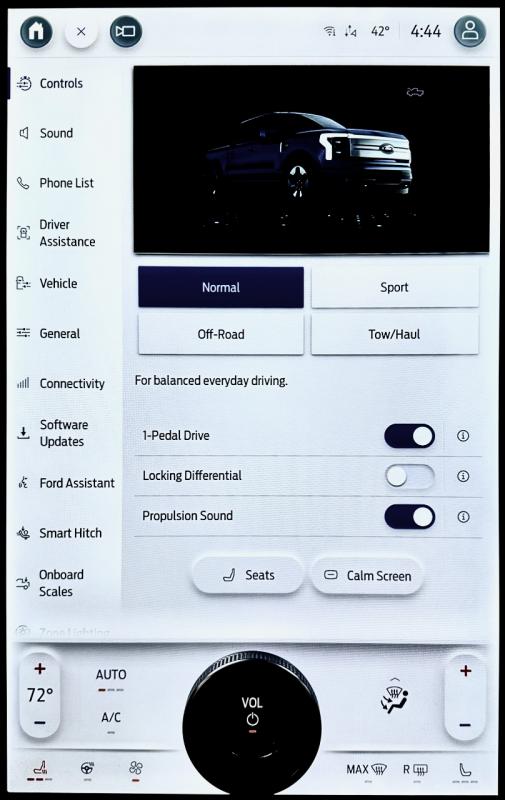 The Lightning is all about screens, information, adjustability and apps. Here, note the four drive modes and that one-pedal driving is activated, along with “Propulsion Sound”—an EV can creep through an intersection quietly enough to startle pedestrians who are staring at their phones.
The Lightning is all about screens, information, adjustability and apps. Here, note the four drive modes and that one-pedal driving is activated, along with “Propulsion Sound”—an EV can creep through an intersection quietly enough to startle pedestrians who are staring at their phones.
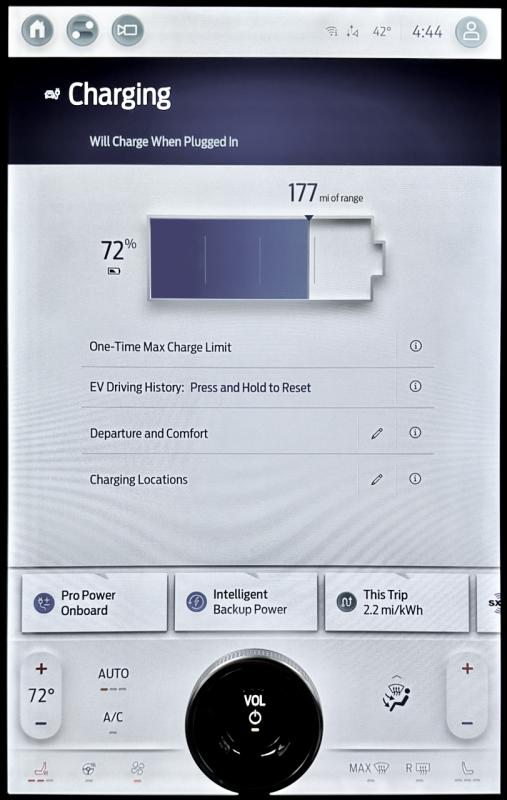 Setting the everyday charging limit to 80% helps prolong battery life; change to 100% for a road trip. This screen also helps the driver monitor charge parameters and find charging points.
Setting the everyday charging limit to 80% helps prolong battery life; change to 100% for a road trip. This screen also helps the driver monitor charge parameters and find charging points.
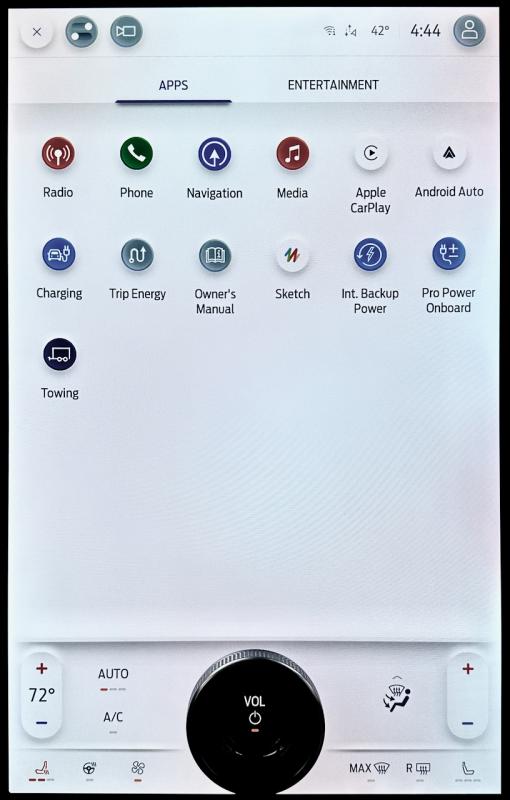 The Lightning offers apps galore as well as an onboard WiFi hotspot. At the bottom of the screen are climate control adjustments, seat and steering wheel heat settings and the stereo on-off and volume controls.
The Lightning offers apps galore as well as an onboard WiFi hotspot. At the bottom of the screen are climate control adjustments, seat and steering wheel heat settings and the stereo on-off and volume controls.
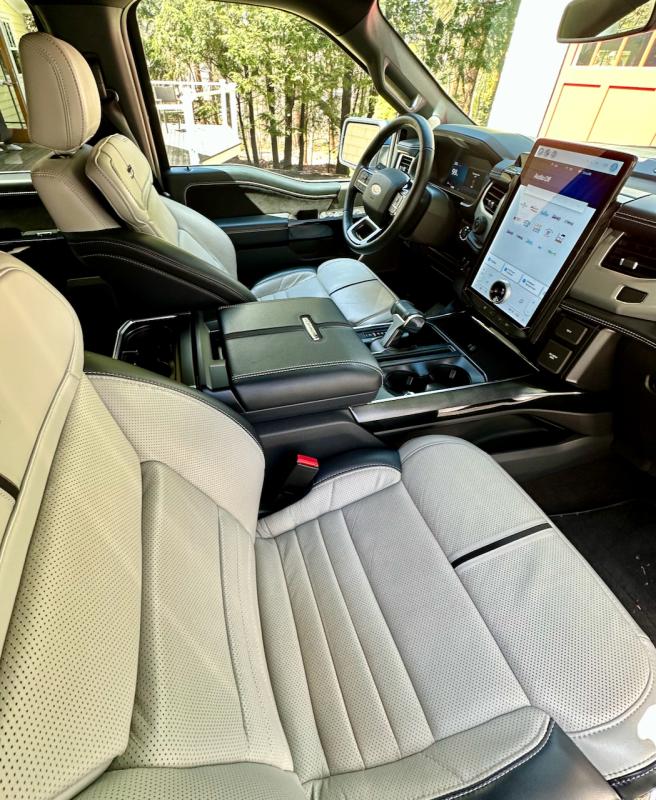 Comfortable, highly adjustable heated seats and a clear and user-friendly touchscreen are the high points of the Lightning Platinum’s cabin. The shift lever folds flat to create a “desk” for a laptop computer.
Comfortable, highly adjustable heated seats and a clear and user-friendly touchscreen are the high points of the Lightning Platinum’s cabin. The shift lever folds flat to create a “desk” for a laptop computer.
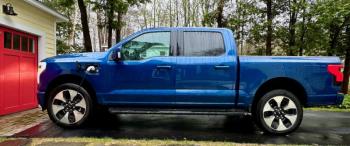 Ford’s trailblazing battery-electric pickup truck is a remarkable achievement—familiar above, extraordinary underneath. This color is Atlas Blue Metallic.
Ford’s trailblazing battery-electric pickup truck is a remarkable achievement—familiar above, extraordinary underneath. This color is Atlas Blue Metallic.
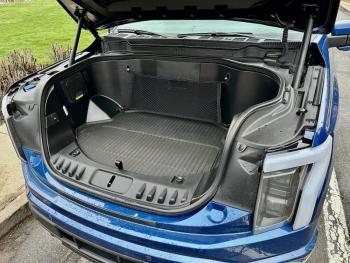 The famous frunk—the front trunk. With an electric motor on each axle, there’s now copious storage where the gas engine used to be. Ford has tuned the suspension to make the Lightning’s balance and weight distribution feel normal.
The famous frunk—the front trunk. With an electric motor on each axle, there’s now copious storage where the gas engine used to be. Ford has tuned the suspension to make the Lightning’s balance and weight distribution feel normal.
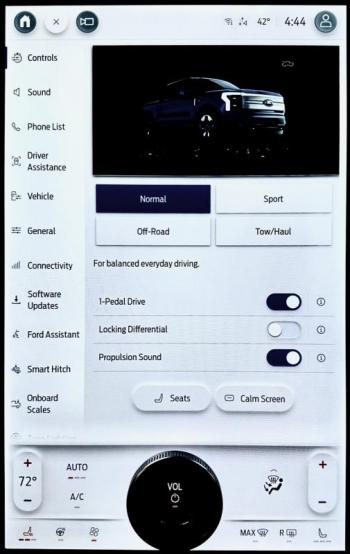 The Lightning is all about screens, information, adjustability and apps. Here, note the four drive modes and that one-pedal driving is activated, along with “Propulsion Sound”—an EV can creep through an intersection quietly enough to startle pedestrians who are staring at their phones.
The Lightning is all about screens, information, adjustability and apps. Here, note the four drive modes and that one-pedal driving is activated, along with “Propulsion Sound”—an EV can creep through an intersection quietly enough to startle pedestrians who are staring at their phones.
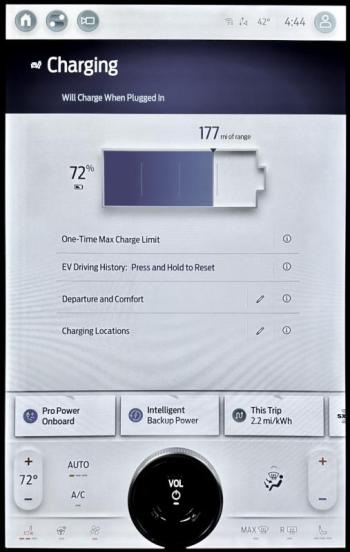 Setting the everyday charging limit to 80% helps prolong battery life; change to 100% for a road trip. This screen also helps the driver monitor charge parameters and find charging points.
Setting the everyday charging limit to 80% helps prolong battery life; change to 100% for a road trip. This screen also helps the driver monitor charge parameters and find charging points.
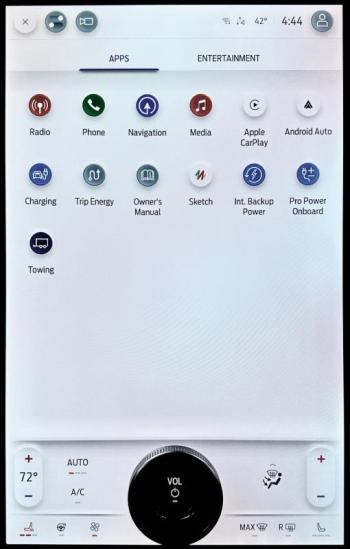 The Lightning offers apps galore as well as an onboard WiFi hotspot. At the bottom of the screen are climate control adjustments, seat and steering wheel heat settings and the stereo on-off and volume controls.
The Lightning offers apps galore as well as an onboard WiFi hotspot. At the bottom of the screen are climate control adjustments, seat and steering wheel heat settings and the stereo on-off and volume controls.
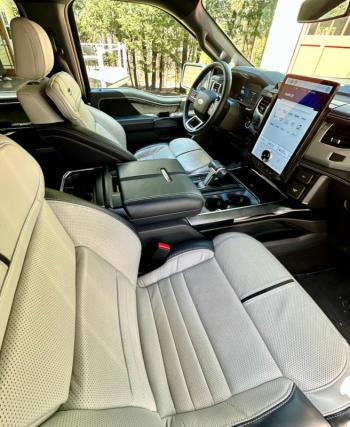 Comfortable, highly adjustable heated seats and a clear and user-friendly touchscreen are the high points of the Lightning Platinum’s cabin. The shift lever folds flat to create a “desk” for a laptop computer.
Comfortable, highly adjustable heated seats and a clear and user-friendly touchscreen are the high points of the Lightning Platinum’s cabin. The shift lever folds flat to create a “desk” for a laptop computer.
Shock and amazement, but the new vehicle I was most interested in driving this year is not an AMG Mercedes or a mid-engine Corvette, but a pickup truck—this one, the electric F-150 Lightning from Ford. Now that I’ve lived with it for a week, I can think of only one thing it’s missing.
Producing the Lightning required enormous investments in engineering, manufacturing and dealer training, and Ford seemed to be going out on a limb. Would pickup-truck buyers adopt something so futuristic and green?
Remember that in 2015 Ford began making F-150 bodies out of aluminum, to save weight over steel for better performance and fuel efficiency. That too was an extraordinarily expensive and risky investment. But when it became known that aluminum trucks were as rugged as steel and wouldn’t crumple up like beer cans (or even rust), sales proceeded apace.
Presumably by now Ford has recovered or at least amortized that investment. And this time, when Ford announced a battery-electric aluminum F-150, the Lightning, almost 200,000 orders rolled in, or about three years of planned production. Many of those potential buyers weren’t typical pickup owners, either. Every carmaker wants new buyers, and in this case the old buyers weren’t abandoning Ford because they could still order traditional gas-powered trucks. Win-win. (Ford knew it was onto something when orders for its new Mach-E electric Mustang went bonkers too.)
So, I was eager to ride the Lightning. Does it live up to the hype? In a word: Yes. I can’t speak to powering my house with it during a blackout—I don’t have the wiring installed—but yes, it rockets away like its tail is on fire. Yes, it’s dead quiet. Yes, it has good payload and towing capacity. Yes, the dual-motor setup provides all-wheel drive. Yes, it bristles with safety, comfort, tech and work features.
Among other things, our loaded Platinum-trim Lightning included heated front and back seats and steering wheel, parking assist, interactive cruise control, power tailgate and frunk lid, automatic climate control, 360-degree camera, apps galore and Ford’s Pro Power Onboard system, with three outlets—in the frunk, the cab and the bed—that can provide up to 9.6 kilowatts of power. Ford claims this can run an entire residential construction job for up to three days.
And yes, it still feels like a full-size, crew-cab pickup: long and wide and tall outside, roomy inside, rough-riding over bumps and with numb steering and possibly some body-on-frame creaks or rattles waiting in the wings. Drivers of internal combustion-powered Ford pickups will feel right at home in the Lightning; everything looks and feels much the same—except, of course, for the ungodly acceleration and the eerie quiet. And the large touchscreen, like an iPad Pro stood on end.
I used the one-pedal drive setting, which essentially does away with any need to brake—just get off the “gas” and, instead of coasting, the wheels spin a generator that helps recharge the battery pack; the resultant friction slows the truck rapidly. It’s like driving a golf cart, and the brake lights come on even if the brake pedal isn’t depressed.
Of course, the big question with EVs is range, or range anxiety. Our Lightning has the extended-range, 131.0-kilowatt-hour battery pack. When it was 100% topped up, in 40-degree weather the computer predicted 304 miles of driving; a road trip seemed to bear this out. However, hooking up a 10,000-pound trailer, our truck’s rated maximum, would cut the range to less than half of that.
Recharging on ordinary household current takes approximately forever, but upgrading to Level II or III fast-chargers, at home or on the road, cuts this dramatically. According to Ford, a 15% to 80% “fill-up” in the Lightning can take as little as 44 minutes.
As a utility vehicle, the brawny Lightning seems well suited to supporting job sites in town. Towing a horse trailer across Wyoming, on the other hand, would be frustrating in the extreme. (Park the truck, ride the horse.) As a daily driver, the Lightning stands head and shoulders above an ordinary F-150; not only is it emissions-free and requires no gasoline or diesel, not to mention oil changes, but the in-floor battery pack and independent rear suspension also drop the center of gravity and improve the handling.
However, it’s an expensive daily driver. Ford has raised prices substantially since the Lightning’s debut. The least-expensive trim level, the XLT with the base 230-mile battery, now starts at $61,269. Our Platinum Extended Range Lightning lists for $98,669, with destination fees. Ford says that certain models are still eligible for $7,500 in federal tax credits.
That’s if you can find one. Battery problems shut down production for weeks at a time and deliveries to customers have fallen far behind schedule. At present, Ford isn’t even taking new orders for Lightnings (although ordering for Ford’s other EV, the Mach-E, has resumed). Considering the revolutionary nature of the beast, maybe teething problems were to be expected.
In last week’s column my wife, the blind lady who assesses our rides by their ease of ingress, comfort and feel, called the hybrid Ford Maverick XL her pickup truck of choice. Mine is now a Ford too—this one. As a tree-hugger, I’m awed by the technology while as a car guy I’m seduced by the Extended-Range Lightning’s pavement-rippling 580 horsepower and 775 pound-feet of torque.
Ford F-series pickups have been the best-selling vehicles in America for more than half of my lifetime; the Lightning should help continue this streak, once the production and pricing problems are sorted out. Oh, what the Lightning is missing? Some whiz-bang graphics or other visual clue—beyond the light bar across the nose—to this vehicle’s revolutionary nature. It looks too ordinary. But that’s probably reassuring to many pickup buyers.
Next week: Mercedes-Benz GLE 450

